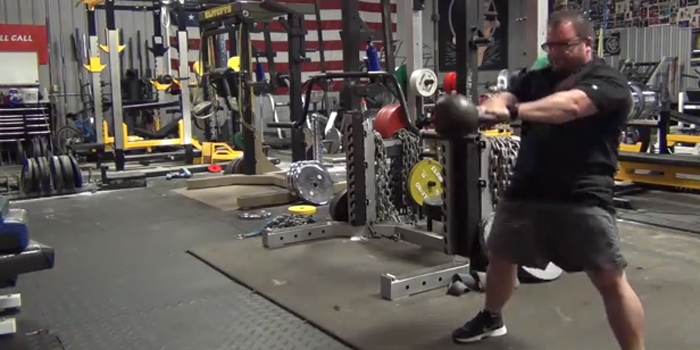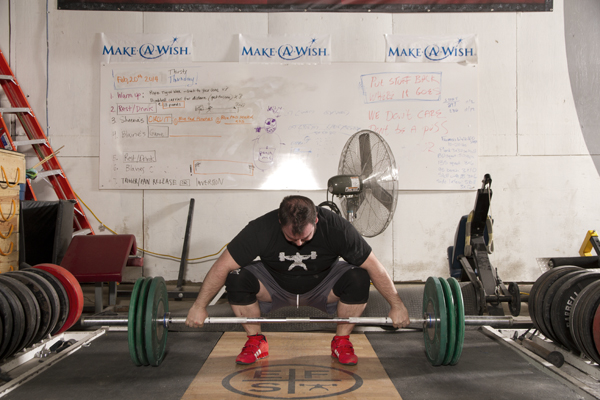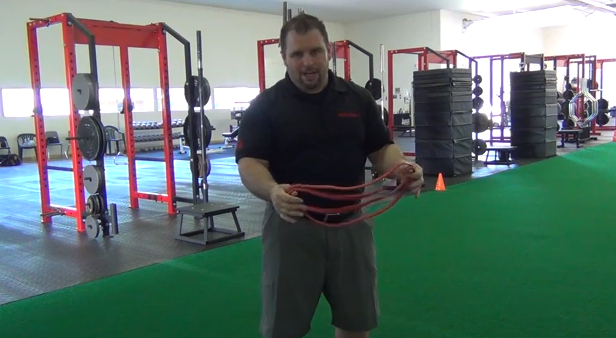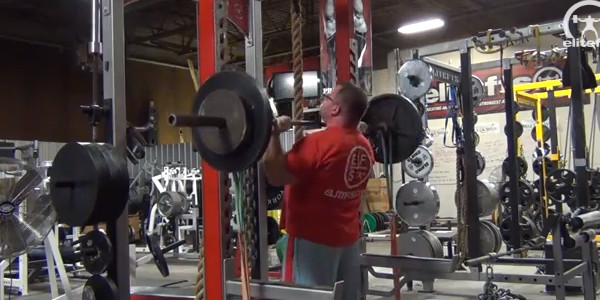
Accommodating resistance has been one of the most misused training tools. Once popularized by Louie Simmons and the WSBB method, now you will see bands and chains at every school and training facility. The issue I always have with noobs using bands and chains is always in the intention of application. Most people are using bands and chains for social media purposes and not for the training effect. How do I know if you are using them correctly?
If you have any slack on the bands
If you have the chains attached to the end of a barbell in one long line.
To clear up these issues, talk a look at JL's tutorial on bands, his clinic on setting up chains, or my instructional rant on chains to make sure you aren't just being a DB.
There are a few thoughts on accommodating resistance including some mistakes I made as a coach.
Bands & Chains for Olympic Lifts
I know there have been coaches that have toyed around with using bands or chains with cleans and snatches. Travis Mash did an outstanding presentation at the 2009 Central Ohio Strength & Conditioning Clinic on using the WSBB method with Olympic lifts. He was up front and honest with what he discovered. Basically he thought they may not be worth implementing for the time allotted. Although I don't suggest using them with any variation that involves a catch. I feel they are a good variation for pulls and obviously for squats.
Olympic coaches stay away from bands and chains because
- They are usually unfamiliar with their implementation
- Olympic lifts are so technical, any variation can alter technique.
Both are understandable.
Although the accommodating resistance can provide an added stimulus to help lifters "finish the pull" or even assist with pulling under the catch; the lifter may have to the increase speed and possible altered bar path to adapt to the movement pattern. This can obviously have a negative effect on the performance of a lift.
Think of a baseball pitcher, throwing a heavier baseball than normal. Prolonged implementation can actually force the pitcher to develop compensation patterns. Because the baseball is heavier, the athletes will ultimately change the way he throws.
The higher the complexity of skill, the less variation the lifter needs
This is why Olympic lifters will have less variation in their programming and les s utilization of special exercises.
s utilization of special exercises.
Anytime you are programming Olympic lifts, always ask these questions.
- Do I have the knowledge base to teach the bio-mechanical positions and the movements?
- Do I have the experience with identifying and addressing technique discrepancies while instituting corrective strategies?
- Do I have enough qualified coaches for the number of athletes I have at one time in my facility?
- Do I have enough time during the training session, training week, and training cycle with my athletes to ensure technical proficiency of the lifts?
- Do I have enough space and enough stations to safely accommodate novice athletes performing explosive movements (some of them overhead)?
- Do I have the proper equipment (the correct bars, bumpers, platforms, or appropriate flooring) for my athletes to execute these movements?
- Are my athletes' chronological, biological, and training ages all conducive of productive training sessions using Olympic weightlifting movements?
Chain or Band Set-Up for Overhead Press
Chains on OHP
The set-up I had tonight is not what I have commonly used or that I have had my athletes use in the past. The benefit of having the chain set up with the end hooked to the bar by a carrabeener is that there is always part of the chain on the ground.
Basically, the set up should be about the same as the squat. With a feeder chain of better yet, the EZ Squat Strap Loader have the 5/8 in chains doubled like normal. By the way, Damn I wish I would have had these EZ loaders when I was a strength coach? You know how much time me or my interns spent county chain links for different set-ups for bench and squat. Not even talking about if you have to make adjustments between athletes.
The major adjustment you need to make is with the length of the feeder chain or hook of the EZ loader. Assuming your squat and OHP back set up is roughly the same height, the OHP feeder chains needs to be longer. For the squat, the 5/8 chains can be almost all the way off the ground except for a few links. As long as all the chains are on the ground at the bottom of the squat, you're good.
For the Overhead press, the 5/8 chain needs to be completely deloaded at the start of the lift. This will allow for the chains to be in contact with the ground for almost all of the range of motion. If your feeder chain is not long enough then you you make want to stack a few mats so the chains can rest on them.
Bands for OHP
Basically, the accommodating resistance of bands allows for more motor-unit and thus muscle fiber recruitment to coincide the the athlete's strength curve. The bands force the lifter to press through the entire range of motion eliciting more effort through the duration of the repetition. Bands can actually add stability at the top of the movement if set-up correctly due to the bands pulling the weight straight down.
With the overhead press, the first band is usually a light or average depending on your strength level and application of the exercise. These should be set up almost identical to the squat depending on the lifter's height. The second band is usually a mini-band or monster mini-band doubled through the first band.
I also would not use bands for Dynamic effort work like the bench press. Your push press, push jerk and split jerks should be your DE work on these. Remember, leg drive IS accommodating the resistance in the case of overhead lifts.
Programming
Incorporating bands into a normal training cycle is relatively easy. Ensure you have the proper band tension based on your strength levels. Just like the squat, take height into account between lifters. This can also be magnified with arm length for any overhead press. One way to implement bands is to keep the weight static and adjust band tension.
4 Week Strength Cycle with Static Weight (Off-Season)
1.) Base Week: 60-75% with light band and monster mini
2.) Load Week: 60-75% with average and min-band
3.) De-Load Week: 60-75% with light band and mini-band
4.) Test Week: 60-75% with average and monster mini
4 Week Tapering Cycle with Static Weight (In-Season)
1.) 50-65% with average and monster mini
2.) 50-65% with average and min-band
3.) 50-65% with light band and monster mini
4.) 50-65% with light band and mini-band
Check out this video on using bands with a Military Press
Bands and Chains for Beginners
I often hear that accommodating resistance is not appropriate for beginners and I can't disagree more. Yes I realize that is is not advisable to add band resistance or an athlete that bench presses 95 pounds. But there are some positives for using bands and chains.
1.) With the load being lighter at the bottom of the movement, this allows for a the athletes to be comfortable at the most precarious position of the lift, especially for the squat. This adds confidence for lifters who have apprehensions about getting depth. Squat depth is almost always the biggest technique discrepancy.
2.) Bands and chains can assist with alleviate soreness. Beginning lifters will get discouraged from DOMS after lifts. The weight being lighter off the chest or at the bottom of the lift can reduce soreness because the load is less at the pre-stretch position.
3.) The obvious benefit is the bands or chains forces the lifter to continue to strain during the entire repetition. More motor recruitment for the same amount of reps can benefit beginners immensely.
4.) Bands especially will force the lifter to "get tight" at the set-up. Bands can give the lifter a false sense of stability because they force the lifter down more than gravity. This can help a lifter set-up in a tight position which will carryover with max attempts.
What I Did Wrong with Bands & Chains with Athletes
I have always been a proponent of using accommodating resistance for beginners but I also see why some coaches want to avoid them. I see both sides. I learned from Kevin Yoxal to be cautious of things you cannot quantify. Bands and chains can fall in that category.
Here are some thoughts I wrote about bands and chains with beginning athletes.
Here is what I did wrong
I standardized the band and chain resistance too much. In order to keep things relatively simple, I used the following resistance.
Squat
Male Athletes
2 Chains per side
Average Bands
Squat
Female Athletes
1-2 Chains per side depending on sport
Light bands
Bench
Male Athletes
2 Chains per side
Doubled Minis
Bench
Female Athletes
1 Chain per side
Doubles Micros
Although the set-up, and resistance was all standard, there were too many other factors that played into this. Mostly limb length and height. The 6"2 outside hitter will have a much more formidable task than the 5'4' setter.
Here is the problem with accommodating resistance.
Lets take two athletes. A 200lb squatter and a 500lb squatter. If the 500lbs squatter goes from 400lbs with chains to 440 with chains; he essentially has gotten stronger as long as the chains were set up the same way. That is the premise I worked on.
That is not the issue, the issue is the training effect would be different. Here is the issue:
Let's use this example:
500 + 80lbs of chain = 580 at the top
200 + 80lbs of chain = 280 at the top
Lets assume there is a full deload (there wont be) just for easy math.
500 to 580 there is a 13% increase in weight during the course of the lift.
200 to 280 there is a 28% increase in the course of the lift. The accommodating resistance much higher percentage of the total load lifted.
The same can be said with bands. With average bands, depending on height of the athlete, this could be close to 50% of the total weight lifted for a sub 200lbs squatter. As compared to 1/4 of the total weight for someone squatting 500lbs or more.
What need to happen was a simple grid that has always existed that I could have implemented in programming.
Squat
below 100lb: No chains
100-200lbs: 1 chain
200-300lbs: 2 chains
300-400lbs: 3 chains
400-500lbs: 4 chains
500-600lbs: 5 chains
This may be a logistical issue to add more chains the weightroom, but now a percentage based system will become more accurate.
Squat
below 100lb: monster mini
100-200lbs: light
200-300lbs: light & monster mini
300-400lbs: average
400-500lbs: average & light
500-600lbs: heavy bands
Again, this may standardize the amount of band resistance in comparison to the max. By simplifying the accommodating resistance, I may have elicited different training effects from different leveled athletes.
Does the stronger athlete need more or less of a chance in resistance? It may actually be the opposite of what you are looking for.
MONDAY
DE Box Squats
200 for 5 doubles
supersetted with box jumps
LB Circuit
Glute Ham-Raise 1x10
GHR Sit-Up 1 x15
Single Leg 45 Degree Back Raise 1 x10
TUESDAY
Hang Snatch
105 for 5 doubles
Dynamic Bench Press with Chains
195 + 3 chains for 5 triples
supersetted with...
Ring Rows
5,5,5,5,20













1 Comment